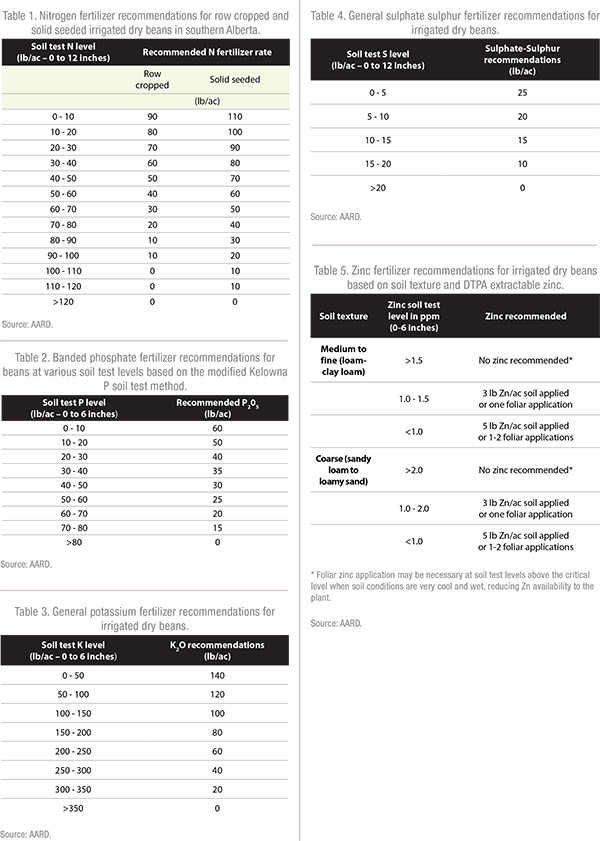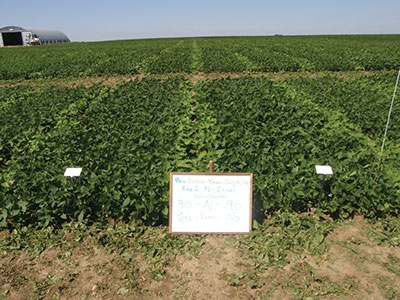
Features
Agronomy
Irrigation
Fertilizing irrigated dry beans
Dry beans yield very well under irrigation, providing excellent economic returns when grown in the Brown soil zone of southern Alberta. Benefits to including beans in a crop rotation include reduced nitrogen fertilizer requirements compared to cereal and oilseed crops, greater residual soil nitrogen levels for subsequent crops and more diverse crop rotations. To achieve optimum bean production specific fertilizer management is required.
Soil sampling and testing: This gives a good inventory of soil nutrient levels and provides the basis for recommending additional nutrients on an individual field basis. Ideally, samples should be taken at zero- to six- and six- to 12-inch depths from at least 20 locations within a uniform field and then bulked into composite samples.
Inoculant: Beans are a legume crop but only fix about 30 to 50 per cent of their total nitrogen (N) requirements. The remaining N comes from mineralization of soil N and from N fertilizer. When beans are properly inoculated with Rhizobium phaseoli bacteria, the bacteria infect bean roots and form nodules on the roots which fix N from the air. Inoculants come in powdered, granular or liquid form.
It takes three to five weeks after seeding for the bacteria to infect plant roots, form nodules and start fixing N. Nodules that are reddish or pink inside indicate the bacteria are functioning and fixing N. Nodules are likely not fixing N when they appear white, grey or greenish when cut in half.
Alberta research has shown that response to inoculant is not consistent in increasing bean yield. Generally, yield benefit of inoculation will range from two to 12 per cent. The benefit of inoculation tends to be reduced when fields that have had a history of inoculant use from past bean production results in a build-up of rhizobia bacteria in the soil.
Nitrogen (N): When growing beans in soil testing less than 80 to 100 lbs. of N/ac in the zero- to 12-inch depth, additional N fertilizer is often beneficial to achieve optimum yield. In a cool spring, when nodules are slow to develop, plants may not be able to obtain sufficient N from the soil, resulting in deficiency and delayed crop growth. Therefore, in soils deficient in soil N, a modest application of N fertilizer can be a good investment.
Alberta research shows that optimum bean production is generally achieved when the soil N in the zero- to 12-inch depth plus fertilizer N total is between 80 to 100 lbs. N/ac, when beans are grown as a row crop. There has recently been increased interest in growing beans as a solid seeded crop. When beans are solid seeded, the yield potential is generally slightly higher. For solid seeded beans, it is recommended that soil N in the zero- to 12-inch depth plus fertilizer N, should total between 100 to 120 lbs. N/ac (Table 1). It should be noted the N fertilizer recommendations for solid seeded beans is preliminary and field research by Alberta Agriculture and Rural Development (AARD) is ongoing to finalize these recommendations.
Excess N fertilizer may reduce the amount of N fixed by beans and could delay crop maturity. To date, ARD research has not shown a benefit of in-crop N fertilizer application. However, ESN (polymer coated slow release nitrogen) fertilizer has sometimes shown benefit over using only 46-0-0 urea fertilizer. Farmers growing beans, particularly on sandy soils, may find benefit of using a portion of N fertilizer as ESN.
Phosphate (P2O5): Table 2 provides recommendations for phosphate fertilizer based on soil test analysis using the modified Kelowna method. The recommendations are based on banded phosphate fertilizer near the seed. Broadcast incorporated rates should be increased by 1.5 to two times to be equally effective on low P soils.
Potassium (K): Beans tend to have a higher requirement for K and often require almost as much potassium as nitrogen. Only 20 to 25 per cent of K taken up by a bean plant is contained in the seed at harvest. The remaining K is in the leaves and stems, which is returned to the soil after harvest.
Many southern Alberta soils are medium to high in exchangeable potassium, often ranging from 400 to 1000 lbs of K/ac in the zero- to six-inch depth of soil. Generally, K deficiencies are most likely to occur on intensively cropped sandy soils. Table 3 provides general recommendations for potassium fertilizer requirements when soils are less than 300 lbs. K/ac. It is best to either band K before seeding or sideband at the time of seeding. Broadcast incorporated K should be increased by 1.5 times to be as effective as banded K application on deficient soils.
Sulphur (S): Deficiencies of S are normally not a problem on irrigated soils in southern Alberta. Irrigation water generally contains enough sulphate-sulphur (SO4-S) to meet crop requirements. If soil S levels are less than 20 lbs/ac in the top 12 inches (30 cm), Table 4 can be used as a guide to decide if S fertilizer is required and what rates to use. If sulphur is required, apply a sulphate containing fertilizer such as ammonium sulphate (21-0-0-24) to correct the deficiency.
There are times when S deficient areas are found on sandy soils or in a small percentage of a field in the surface soil. Sulphur deficiency may occur on sandy soil after heavy precipitation events leach the sulphate from the surface soil into the subsoil. This can result in the surface soil being deficient in sulphate, yet there may be adequate sulphate in the subsoil.
Micronutrients: Beans require all the essential micronutrients. Micronutrient research with beans in Alberta has only identified zinc (Zn) as occasionally being deficient and usually only on sandy soils.
From limited Zn response research data, Zn fertilizer recommendations have been developed (Table 5). Recommendations are based on soil texture and soil Zn analysis of a 0 to 6 inch soil sample depth using the DTPA extractable zinc method.
Banding zinc before or at the time of seeding is the preferred method of application. However, soil applied zinc sulphate could be substituted with one or two early foliar applications in June.
Zinc deficiency can be induced by cool, wet soil conditions in spring, which may reduce soil zinc availability to the crop. Beans grown in soils that have soil test Zn levels above the critical level may still show visual symptoms of Zn deficiency during wet, cool conditions in June. Beans will often grow out of the deficiency as the weather warms up. However, if cool weather conditions are prolonged, a foliar application may result in some benefit.
 |
April 23, 2014 By Ross H. McKenzie PhD P. Ag.
 Solid seeded bean trial at Bow Island Dry beans yield very well under irrigation
Solid seeded bean trial at Bow Island Dry beans yield very well under irrigation